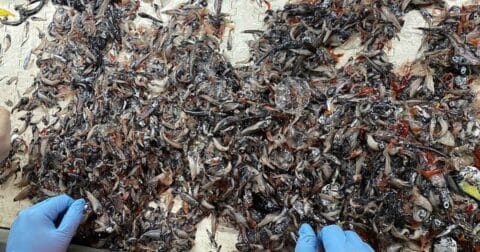Perspective
Can Men Help the Climate by Eating Less Meat?
Climate•5 min read
Solutions
Though there is no moratorium, fishing the mesopelagic layer remains out of bounds.


Words by Shi En Kim
Deep below the surface of the ocean are the parts left mostly unexplored and where sunlight barely touches. One of these is called the mesopelagic layer, so-named for its spot in the middle of the pelagic zone. This “twilight zone” of the ocean contains more fish than at any other depth: estimates range from 1 to 10 billion metric tons. Until recently, the fish that dwell there remained mostly untouched by fishing vessels. But growing demand for farmed fish spurred the industry to explore new depths, urgently looking for more tiny fish to use as feed.
The “twilight zone” contains 90 percent of the ocean’s total biomass in fish. These strange-looking creatures are well-adapted to the constant pall at 660 to 3,300 feet below. They often sport googly eyes, translucent bodies and bioluminescent veneers. Appearance and color aren’t important considerations for citizens of a world shrouded in near-darkness.
What the dwellers lack in looks, they make up for in numbers. Since that remains a driving argument for fishing there, researchers have called for a moratorium to prevent future exploitation.
You can’t order mesopelagic seafood in a restaurant or find it at the seafood counter. But there is plenty of seafood industry interest in mesopelagic fish — for turning them into fish oil supplements or aquafeed.
Aquaculture has long been touted as a way to relieve the burden on wild fish operations. Yet the industry itself needs wild fish to operate. Most aquaculture operations use small wild-caught fish, such as anchovies, as fishmeal for larger predatory fish that humans normally put on their plates. While the UN’s Food and Agriculture Organization researchers say data on exact numbers is scarce, research suggests at least some fishmeal stocks are teetering towards depletion. In West Africa, for example, feedfish have been over-harvested by foreign companies. And illegal operators are devastating marine biodiversity, and threatening local livelihoods.
As a substitute for wild-caught feed, some aquaculture operators raise their fish on a vegetarian diet such as soy. But many experts are quick to point out the inanity of this alternative: it’s like forcing a lion into an herbivore lifestyle, Xabier Irigoien, a researcher at AZTI and King Abdullah University of Science and Technology tells Sentient. “We are actually using land and freshwater to grow soy — to grow a fish that really doesn’t need freshwater or land. So we are doing really odd things in terms of food.”
At the same time, our global appetite for fish, especially farmed fish, continues to rise, and the industry is exploring new options. In late 2023, the Norwegian firm Nofima conducted a three-month trial of feeding farmed salmon mesopelagic catch. The researchers observed their salmon growing faster than their counterparts fed a typical protein diet. “It’s very promising,” Ingunn Marie Holmen, a research manager in fisheries technology at the Norwegian research institute SINTEF Ocean, tells Sentient. Nofima “had to actually stop the trial one week early because they ran out of feed.”
Not everyone is on board, however. Since 2020, researchers have called for a global moratorium on mesopelagic fishing, concerned that plumbing these new depths for fish could take a toll on climate action and biodiversity.
All fish, including mesopelagic fish, play a vital role in sequestering atmospheric carbon, slowing the pace of climate change by taking emissions out of the atmosphere. Deep-dwelling mesopelagic fish are even more vital to that process, simply because of where they live. Many of these fish undertake a daily vertical migration, surfacing at night to feed, then returning during the day to hide from predators. Mesopelagic fish exhale carbon dioxide, poop and themselves get eaten by other mesopelagic hunters. And all of these activities help ferry carbon from surface waters to the deeper ocean, where it can be stored more effectively than on land.
Another ecological downside of mesopelagic fishing is the damage to ocean biodiversity. The role of mesopelagic fish in the marine food web is still largely unknown. But researchers know that several epipelagic species, such as dolphins, swordfish and tuna, feed on their submarine neighbors. Trawling in the mesopelagic zone might risk disrupting fisheries at the ocean surface, including those the industry thinks of as the most valuable at market.
“We don’t know the system well enough to start harvesting mesopelagic fish,” says Middle East Technical University oceanographer, Deniz Dişa. Last June, Dişa and her team published a study modeling the impact of mesopelagic fishing in the mid-Atlantic Ocean. The researchers found that even removing a conservative fraction of the mesopelagic stock would lead to cascading effects of carbon cycle disruption, with a decrease of 14 percent in total carbon movement, and food web chaos. According to the team, fishing in mesopelagic waters would only have a 20 percent chance of being sustainable.
The bottom line, Dişa says: the consequences are “not that simple.” And a growing number of ocean researchers agree, arguing that fishing deeper isn’t a solution to dwindling marine stocks — it only punts the problem from one corner of the world to another. Given their unique ecological roles in biodiversity and carbon sequestration, mesopelagic fish are just as worthy of protection as those near the surface, if not more.
“This is a group which is unlike most of the species that we exploit at the moment,” says Callum Roberts, a University of Exeter marine biologist who is among those calling for a mesopelagic fishing ban. “If there’s any part of the ocean that you really don’t want to mess with, it’s the mesopelagic fish.”
For now, there are a number of challenges keeping mesopelagic fishing at bay. Experts say this type of fishing requires high fuel consumption, for one. The fish are also very small, some no larger than a finger pad, so fishers need to deploy nets with fine mesh and contend with high levels of drag.
Mesopelagic fish also spoil easily because they’re full of digestive enzymes, so they have to be processed or frozen promptly. “You almost can’t touch it before it’s all porridge,” Holmen says. According to marine scientist Stein Kaartvedt, one South African ship’s mesopelagic bycatch apparently caught fire because it was so oily.
The fish that hang out in the twilight zone can also be tough to catch. Most are stragglers — they don’t congregate while swimming to make for an easy one-scoop kind of bounty — and they are also notorious for dodging nets.
“They are everywhere,” says Kaarvedt of the University of Oslo, but that doesn’t mean they are easy to catch. “The main thing with fishing is not whether we have 1 billion or 10 billion, but whether you have sufficient concentrations to make fishing feasible.”
The Norwegian fishing industry seems to have come to the same conclusion. In the late 2010s, a group of companies conducted a trial of mesopelagic fishing. The vessels brought in abundant catch in their first attempt, but the next two tries yielded near-empty nets. Since then, the fishing industry there has moved on to more lucrative targets, such as cod and herring. Mesopelagic fishing interest has also watered out in Iceland and South Africa, in favor of mackerel and sardines.
Across the world, more of the fish we eat comes from farms rather than wild-caught fisheries these days. But the proportion of fish stocks that have been classified as overfished has also been growing in tandem. Today, that fraction is 30 percent; and fish populations that are at capacity come in at 60 percent.
Although practically unnecessary at the moment, a moratorium on mesopelagic fisheries would help thwart future exploitation, says University of Exeter’s Roberts. Nevertheless, all that research on the mesopelagic zone is far from wasted, industry proponents say. This is a rare instance of a marine industry sinking time and money into conducting a full cost-benefit analysis before diving in head first. “It could be an example of how to approach expansion of any kind,” says another researcher, Irigoien, for fish as well as other ecosystems and natural resources.